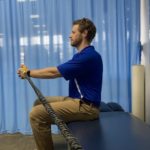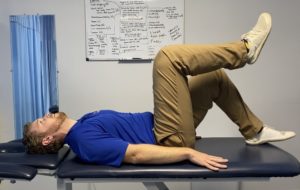At Joints in Motion, we have treatmed many patients with the condition of lumbar spinal stenosis. In fact, it is one of the most common reasons for back pain in those over 60. Unfortunately, it is also the most common reason patients get low back surgery https://www.ncbi.nlm.nih.gov/pmc/articles/PMC2913862/, but surgery does not always have to be the answer. A 2015 study showed that physical therapy and lumbar surgery produced similar outcomes in pain and function after 2 years! https://www.ncbi.nlm.nih.gov/pmc/articles/PMC6252248/ .Weighing treatment options can be tricky when dealing with back pain and sciatica. Those that have stenosis know how debilitating it can be, but there is good evidence and hope that a well designed physical therapy program can prevent low back surgery .
What is lumbar spinal stenosis?
Lumbar spinal stenosis is a narrowing of the spinal canal which is the space where the lower part of the spinal cord exists. When this space narrows, it will cause crowding around the nerves in your lower spine. Nerves like space, so this crowding can cause sensitivity in the nerves. This narrowing can occur for various reasons, but the most common is age related changes. When we age, our bony surfaces become rougher and form outcroppings that can encroach on the spaces where our spinal nerves run. Lumbar spinal stenosis is a diagnosis that is made with both clinical and imaging information, meaning the symptoms you have combined with MRI and radiographic findings are needed to make an accurate diagnosis. This is because MRI and x-ray findings of stenosis occur in people who have no back pain or leg pain. In fact, 50% of people over the age of 60 will have these changes in their spine upon imaging, however, only a fraction of them will have pain and other deficits.
What are the symptoms of stenosis?
People with this condition may or may not have back pain. The thigh and leg pain is what stands out in this condition. Burning, numbness, pain, and tingling are all commonly reported. Sometimes, it is even challenging to describe the feeling in your legs. Symptoms are typically located in the buttocks, thighs, lower legs, feet, or all of the above. One or both legs may be involved. One leg may be worse than the other. Typically symptoms will become more intense the longer the person stands or walks. Relief is felt with sitting, bending forward, or leaning on an object like a desk or shopping cart.
How can physical therapy help?
“How is a physical therapist going to change what’s going on in my spine?” This is a frequent question I get asked when treating lumbar spinal stenosis. A physical therapist is not going to change the bony anatomy of your spine and they are not going to reverse any age related changes that happen in all human spines, but they are really good at dosing an exercise program that will allow the spine and nervous system to adapt. We already know that there are plenty of asymptomatic people out there with imaging that shows they have stenosis, so the idea is to not change the anatomy but to change the symptoms. https://www.ncbi.nlm.nih.gov/pmc/articles/PMC3775665/,
https://pubmed.ncbi.nlm.nih.gov/2312537/
The nervous system can adapt over time. A physical therapist will help you gradually progress towards an activity or goal that you want to achieve. An example of this can be seen in a patient I have worked with recently. She is a person that puts a high priority on exercise, in fact she makes it a point to exercise every morning, and she had been doing so for years. Her favorite forms of exercise are walking and elliptical. Gradually she started to notice left leg burning and pain when on the elliptical. At first, she ignored the burning thinking it would get better. When the pain continued, she stopped going to the gym altogether.. She was scared that exercise was only making her problem worse. When she came to see us, the last thing I wanted for this person was for her to give up her exercise habit. When we evaluated her, we found certain exercises helped alleviate her leg pain in the short term, but we also came up with a plan to build back her tolerance to walking and elliptical training without giving up her daily exercise routine. We substituted elliptical for a NuStep and walking for a rowing machine. She was able to get the same calorie burn with these two substitutes without increasing her symptoms. In PT, we worked on her leg and hip strength as well as her hip and back flexibility. We gradually built back her tolerance to walking, elliptical, and other upright exercise. Slowly we added walking and elliptical back into her exercise routine until she was able to reach her goal of 30 minutes per day!
Lumbar spinal stenosis is a difficult condition to live with, but it can be treated and managed without surgery in most cases. Physical therapy is a great treatment option and should be strongly considered if you have been diagnosed with this condition.
Exercise Examples for Lumbar Stenosis













